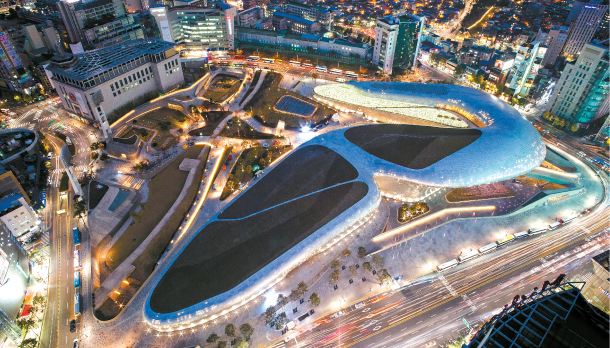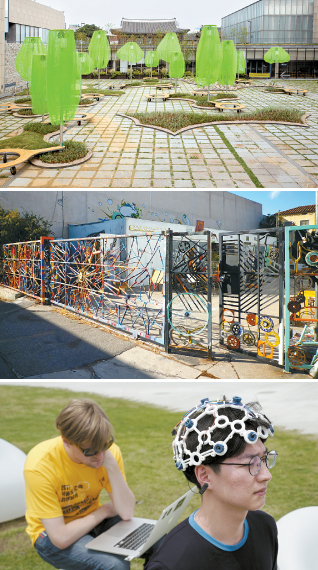This fall, Seoul is the global hub of architecture : Throughout the city, events will offer opportunity to learn more about future of urban design

The Dongdaemun Design Plaza in central Seoul, completed in March 2014, will host many upcoming architecture festivals in September, including the UIA 2017 Seoul gathering of architects and the Seoul Biennale of Architecture and Urbanism. [SEOUL DESIGN FOUNDATION]
As the International Union of Architects (UIA) World Congress is being held in Korea for the first time, a series of other architecture events are opening in step with the global gathering of the building designers. From the launch of the Seoul Biennale of Architecture and Urbanism to a series of projects created by students and artists alike, this autumn is rich with opportunities to witness the future of architecture all over the world.
Experts ascend on Seoul

From the top: The Young Architects Program 2017 is on display at MMCA until Oct. 9, where “Paper and Concrete: The Modern Architecture of Korea” will open on Sept. 1; “Recycling: A Back-to-the-City Movement” which will be on display at the Seoul Biennale of Architecture and Urbanism at the DDP; A live workshop project will analyze the brain activity of a pedestrian to produce the best environment to walk in at the Seoul Biennale. [MMCA, SEOUL BIENNALE]
Kicked off in Lausanne, Switzerland, in 1948, the UIA World Congress is the premiere forum for those interested in architecture led by the most prominent architects around the globe. The theme of this year’s congress is “Soul of City.”
“Only a living creature owns a soul,” according to the organizers of the event. “And a body without a soul is only a corpse. 2017’s theme therefore projects our strong commitment and determination to acknowledging the importance of having souls dissolved in architecture and cities we live in.”
Starting with the opening ceremony on the morning of Sept. 4, the congress and the general assembly include keynote speeches and forums featuring professional architects, pavilion sessions by students and young architects, exhibitions and social gatherings for architects from all walks of life.
The last three days of the gathering feature a general assembly at the DDP. The panel of speakers includes: Seoul Mayor Park Won-soon, Principal of Zaha Hadid Architects Patrik Schumacher, architect Dominique Perrault, architect Cho Min-suk and Kobkarn Wattanavrangkul, minister of Tourism and Sports in Thailand.
The event seeks to delve into the five realms of urban architecture for reviving the soul of the city - culture, future, nature, passion and human values.
The UIA 2017 Seoul will run through Sept. 3 to 10. COEX is located in southern Seoul, Samseong station, line No. 2. DDP is located at the Dongdaemun History and Culture Park station, line Nos. 2, 4 and 5. For more information, visit www.uia2017seoul.org or call (02) 6288-6349.
Celebrating the city’s possibilities
From Sept. 2 until Nov. 5, the Seoul Biennale of Architecture and Urbanism will be held for the first time in the Korean capital. The biennial festival will focus on the identity of a city as a whole, rather than parts of its infrastructure such as buildings or roads.
Co-organized by the Seoul Design Foundation and the Seoul Metropolitan Government, the festival includes a variety of exhibits on how to change the face of Seoul into a sustainable city that utilizes the limited resources of the modern world, while transforming the capital into a space for all citizens and generations to share.
“Employing architecture and urbanism as media, Seoul Biennale of Architecture and Urbanism encompasses a wide range of fields - from sociology, geography, and economics to literature, art, theater and film - to engage in the present and future cities of the world,” said the foundation.
The biennale is divided into four main programs that take place at either the DDP, the Donuimun Museum Village in central Seoul or other meaningful sites within Seoul, such as the Seoul Museum of History. The Thematic Exhibition features 40 projects on how to make the best of the resources and food we have in our world, while the three other exhibits focus on either remodeling or reusing the city’s facilities to make the transition into the Fourth Industrial Revolution.
The Seoul Biennale of Architecture and Urbanism will be held from Sept. 2 to Nov. 5 at various parts of Seoul. To go to the two main venues, get off at Dongdaemun History and Culture Park station line. Nos. 2, 4 and 5 for DDP, and get off at Seodaemun station, line No. 5, exit 4. For more information, visit www.seoulbiennale.org or call (02) 2096-0180.
Rejuvenating forgotten spaces
The massive oil reserve near the Seoul World Cup Stadium was built in 1976 to store extra oil in case of an emergency. In 2002, when the World Cup Stadium was built nearby, the reserve was emptied and shut down. The facility was closed to the public for over 15 years as it was deemed too hazardous for visitors to explore. Thanks to the Seoul Metropolitan Government’s efforts to revive old parts of the city, the oil reserve will re-open its doors as the Oil Tank Culture Park in September and it will be the venue for the 9th Seoul Architecture Festival (SAF).
For three weeks starting on Sept. 1, SAF will show the works of architects inspired by the theme of “Blurring the Boundaries.” The venue itself, with a size of 140,000 square meters (34.6 acres), offers a great deal of space for architects and the public to enjoy.
At this festival, visitors get to see what architects have come up with to create an organic and open city layout. Aside from the regular exhibition of the nominees for this year’s Seoul Architecture Award, other programs include: college workshops, open seminars and discussions between the architects and the public.
The 9th Seoul Architecture Festival will run from Sept. 1 through 24. To go to the Oil Tank Culture Park, get off at the World Cup Stadium station, line No. 6, exit 2 or 3, and walk 10 minutes. For more information, visit www.saf.kr or call (02) 337-2587.
Urban design as art
Large conferences and seminars aren’t the only places for an architectural experience. Throughout the city, visitors can see the works of artists and architects who have expressed their own ideas about design and the future of the urban life.
Art Center Nabi will display the “Sharable City” project by architecture students, studios and media artists who have joined forces to give solutions to urban problems including youth unemployment, lonely senior citizens and the single-person households. By reusing and reconnecting once-abandoned resources within the city, the project aims to tackle, or at least try to give an answer to, humanitarian problems by changing the living environment for Seoulites.
On Sept. 5, the Seoul Upcycling Plaza will hold its opening ceremony to the public, with an opening conference and outdoor flea market. Upcycling refers to the act of creating value through recycling something that has lost its initial use.
The building itself is designed to reuse 20 percent of its heat emission to generate power, and the plaza will provide visitors an opportunity to see how materials are upcycled through various ways. The facility will also offer start-ups the opportunity to use some space, without having to worry about costs.
More artistic approaches are also available. The main branch of Seoul Museum of Art in central Seoul is playing host to the “Evolving City” exhibition, which features the works of artists who have visualized a future in which architecture and nature have come together to create a new concept of spaces for humans to live in. Through four sections that follow the history of Seoul from 1392 - the foundation of the Joseon Dynasty - to the future design of the capital, viewers can see how the city has evolved into its current form, and what is in store in the future.
The Museum of Modern and Contemporary Art in central Seoul will display its collection of works by Korean architects from the late 1980s to the early 2000s at an exhibition titled “Paper and Concrete: The Modern Architecture of Korea.”
Rather than focusing on the architects’ works as creations of individual imagination, the exhibition sheds light on how the environment affected the thoughts of the creators, and how the dynamics have shaped the surroundings.
“Sharable City” project will be on display from Sept. 2 to Nov. 5, at Art Center Nabi in central Seoul. Get off at Jonggak station, line No. 1, exit 6.
The Seoul Upcycling Plaza is located near Dapsimni station, line No. 5, exit 5, open everyday from 10 a.m. to 6 p.m.
“Evolving City” will be held from Sept. 3 until Nov. 12 at the Seoul Museum of Art. Get off at City Hall station, line No. 2, exit 10 and walk for five minutes.
National Museum of Modern and Contemporary Art Seoul is a 10-minute walk from Anguk station, line No. 3, exit 1.
Architecture on screen
The Architecture & Design Film Festival (ADFF) began on July 28 at Storage by Hyundai Card, an art exhibition gallery in central Seoul and runs until Oct. 29.
The film fest features 24 movies about the creative minds of architects and how they have come to create their projects, under four different themes. As the world’s largest architecture and design film festival, ADFF strives to bring together talent from all fields and generations. Movies that give insight into what happens behind the scenes at a construction site or design labs allow viewers to discover the stories of the buildings around them that they take for granted every day.
From Sept. 4 to 18, the 9th Seoul International Architecture Film Festival (SIAFF) will also screen movies about how architects create their masterpieces, and how the fruits of their creative labor help make society a better place to live in. By showing architecture movies from around the world, the festival urges the public to see not only the technical minutiae behind making a building, but also the artistic and sociological meaning behind every design in modern day architecture. This year’s theme, “Walking Architecture,” highlights the creation of buildings that communicate with society.
Storage by Hyundai Card is in Itaewon, central Seoul. Get off at Hangangjin station, line No. 6, exit 3, and walk 10 minutes. For more information, visit storage.hyundaicard.com or call (02) 2014-7850.
SIAFF screens its movies in two venues: For Korea Institute of Registered Architects, get off at Nambu Bus Terminal station, line No. 3, exit 2; For Arthouse Momo in Ewha Womans University, get off at Ewha Womans University station, line No. 2, exit 2 or 3. For more information, visit www.siaff.or.kr or call (02) 3415-6826.
BY YOON SO-YEON [yoon.soyeon@joongang.co.kr]










with the Korea JoongAng Daily
To write comments, please log in to one of the accounts.
Standards Board Policy (0/250자)